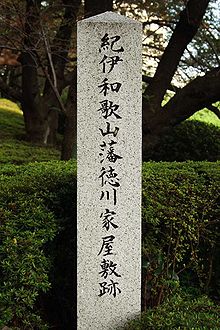Kishu (Han)
Kishū ( Japanese 紀 州 藩 , -han ) was a Han ( fiefdom ) in Japan in the Edo period , which existed from 1586 to 1869. It is named after the old province Kii (Kishū), in which it was, today the prefecture Wakayama and the southern part of the prefecture Mie , and the castle town Wakayama as Kii-Wakayama , respectively just as Kii or only as Wakayama . The income of the Han was measured at 555,000 koku .
The daimyō (feudal lords) of Kishū were first the Kuwayama family ( 桑 山 ), at that time the fiefdom was only 20,000 koku. After the Battle of Sekigahara , however, the fiefdom changed into the hands of the Asano ( 浅 野 ) in 1601 and was massively increased to 376,000 koku.
Finally, in 1619, the fief was given to Tokugawa Yorinobu , the tenth son of Shogun Tokugawa Ieyasu and originally feudal lord of Sumpu in the province of Suruga . Thus his line became the Kishū-Tokugawa , one of the three original branch lines of the Tokugawa , the so-called Gosanke . As relatives of the Shogun, the Kishū-Tokugawa were at the highest rank of the Shimpan-Daimyō . The fifth in the line, Yoshimune , was adopted into the parent company in 1716 and Shogun himself, because the main line had no heir. The new liege lord was then Matsudaira Yoriyoshi ( 松 平 頼 致 ), liege lord of Saijō in the province of Iyo , who took the name Tokugawa Munenao .
When the new line of the Tokugawa with the childless Tokugawa Iesada died out, in 1849 a heir from the Kishu line, Tokugawa Yoshitomi, who took the name Iemochi , was reinstated .
List of daimyo
- Kuwayama ( Tozama-Daimyō , 30,000 Koku → 20,000 Koku), 1586–1601
| Surname | Kanji | Term of office | Remarks | |
|---|---|---|---|---|
| 1 | Kuwayama Shigeharu | 桑 山 重 晴 | 1586-1596 | |
| 2 | Kuwayama Kazuharu | 桑 山 一 晴 | 1596-1601 | Then daimyō of Yamato-Shinjō 1600–1604 |
- Asano ( Tozama-Daimyō , 376,000 Koku), 1600–1619
| Surname | Kanji | Term of office | Remarks | |
|---|---|---|---|---|
| 1 | Asano Yoshinaga | 浅 野 幸 長 | 1600-1613 | |
| 2 | Asano Nagaakira | 浅 野 長 晟 | 1613-1619 | Previously daimyo of Ashimori 1610-1613 and then Hiroshima 1619-1632 |
- Kishū-Tokugawa ( Shimpan-Daimyō , 555,000 Koku), 1619–1869
| Surname | Kanji | Term of office | Remarks | |
|---|---|---|---|---|
| 1 | Tokugawa Yorinobu | 徳 川 頼 宣 | 1619-1667 | Previously daimyo by Mito 1603-1609 and by Sumpu 1609-1619 |
| 2 | Tokugawa Mitsusada | 徳 川 光 貞 | 1667-1698 | |
| 3 | Tokugawa Tsunanori | 徳 川 綱 教 | 1698-1705 | |
| 4th | Tokugawa Yorimoto | 徳 川 頼 職 | 1705 | Previously as Matsudaira Yorimoto ( 松 平 頼 職 ) daimyō by Takamori 1697–1705 |
| 5 | Tokugawa Yoshimune | 徳 川 吉 宗 | 1705-1716 | Previously as Matsudaira Yorikata ( 松 平 頼 方 ) daimyō of Kazurano 1697–1705 and then Shōgun 1716–1745 |
| 6th | Tokugawa Munenao | 徳 川 宗 直 | 1716-1757 | Previously as Matsudaira Yoriyoshi ( 松 平 頼 致 ) daimyō of Saijō 1711–1716 |
| 7th | Tokugawa Munemasa | 徳 川 宗 将 | 1757-1765 | |
| 8th | Tokugawa Shigenori | 徳 川 重 倫 | 1765-1775 | |
| 9 | Tokugawa Harusada | 徳 川 治 貞 | 1775-1789 | Previously as Matsudaira Yoriatsu ( 松 平 頼 淳 ) Daimyō of Saijō 1753–1775 |
| 10 | Tokugawa Harutomi | 徳 川 治 寶 | 1789-1824 | |
| 11 | Tokugawa Nariyuki | 徳 川 斉 順 | 1824-1846 | Previously head of the House of Shimizu Tokugawa ( Gosankyō ) 1805–1816 |
| 12 | Tokugawa Narikatsu | 徳 川 斉 彊 | 1846-1849 | Previously head of the House of Shimizu Tokugawa 1827–1846 |
| 13 | Tokugawa Yoshitomi | 徳 川 慶福 | 1849-1858 | Subsequently as Tokugawa Iemochi ( 徳 川 家 茂 ) Shogun 1858–1866 |
| 14th | Tokugawa Mochitsugu | 徳 川 茂 承 | 1858-1869 |
